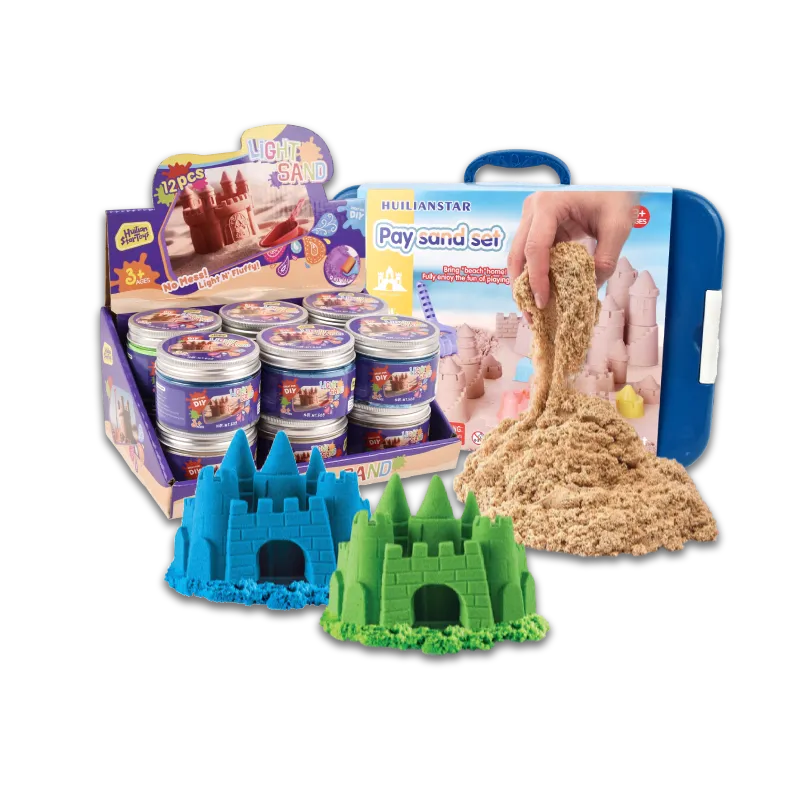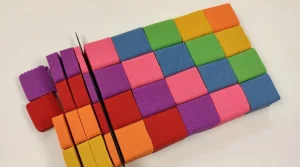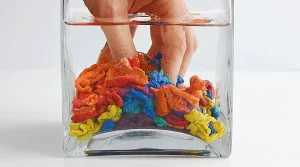
What Is Sensory Sand Made Of? The Science and Benefits
Explore what sensory sand is made of, why children love it, and how its unique materials enhance learning, creativity, and fine motor skills.
#1 Toys Manufacturer in China. WhatsApp: +86 180-0088-4063. Email: [email protected]
#1 Toys Manufacturer in China. WhatsApp: +86 180-0088-4063. Email: [email protected]

Kinetic sand toys look simple at first glance: soft grains that cling together yet move like a liquid. This strange mix of solid and fluid is what makes them so fascinating for both kids and adults. Many children describe it as “alive,” while parents often say it feels almost therapeutic to touch.
In recent years, sensory play tools like kinetic sand have moved from niche products into classrooms, therapy rooms, and homes. Teachers use them to create hands-on lessons. Therapists bring them into sessions with children who need calm and focus. At home, families set them on the table as an easy way to combine play with quiet time.
Kinetic sand toys are more than just buckets of sand. They are made from fine grains coated with a special polymer that gives the sand its unique texture. This coating lets the grains stick together while still moving smoothly, almost like wet sand that never dries out.
Children often notice the difference right away. Unlike beach sand, which can scatter everywhere, kinetic sand holds its shape. You can press it into molds, slice it with tools, or let it crumble between your fingers. Because of this, it works well for both free play and guided learning.
Scientists describe kinetic sand as a non-Newtonian material. This means it does not behave like ordinary solids or liquids. Instead, its movement changes depending on pressure. When pressed hard, it holds form. When handled gently, it flows. This unusual property explains why it feels so satisfying to squeeze and release.
Sensory play is more than fun. It helps the brain process information from the world. Kinetic sand toys are one of the simplest tools for this kind of play. Their soft, flowing texture gives children a chance to explore touch in a safe and controlled way.
Teachers and therapists often point out that sensory materials like kinetic sand can support both learning and emotional growth. Unlike some tools that require instructions, sand invites natural curiosity. A child does not need directions to begin pressing, shaping, or crumbling it.
Touch is often called a “hidden sense.” It gives feedback about pressure, texture, and resistance. When children press kinetic sand between their fingers, they learn about these qualities in real time. The shifting grains respond instantly, which makes the experience both predictable and surprising.
A six-year-old might spend twenty minutes burying shells in a tray of sand and digging them back out. This simple game is more than play. It is a way to test how objects feel, how they move, and how the hand controls them. Over time, this kind of exploration supports better awareness of touch.
Adults often notice the calming effect of kinetic sand as well. The slow motion of squeezing and releasing can reduce restlessness. Many therapists compare it to stress balls or clay, but with a smoother flow that invites longer play.
In some classrooms, teachers set aside small trays of sand for quiet breaks. Children who feel overwhelmed can sit, shape, and reset. The rhythm of the hands in the sand often helps them return to lessons with more focus. It is not magic, but it is a clear reminder of how touch can guide attention and calm the mind.
Cognitive development is about how children think, learn, and solve problems. Kinetic sand toys, while playful, can quietly support these skills. The open-ended nature of the material lets children explore ideas without pressure or strict rules.
Unlike digital screens that give instant answers, sand play asks for patience. Each step—pressing, molding, or cutting—requires attention. This slow pace naturally supports focus and mental flexibility.
Staying focused is not easy for young children. Kinetic sand encourages longer play sessions because the material constantly changes but never loses its form. A child can shape a tower, watch it crumble, and then rebuild it. This cycle draws attention back again and again.
Some teachers use short play periods with sand before reading lessons. They notice that children are calmer and more ready to concentrate. While research is still developing, early studies on sensory play suggest a link between tactile activities and improved sustained attention (Bodrova & Leong, 2007).
>> Can Kinetic Sand Go Down the Sink? What You Needs to Know!
Sand does not always behave the way children expect. A wall might collapse or a bridge might sag. To fix it, they must adjust how much pressure they use or try a different shape. This trial-and-error process is at the heart of problem-solving.
Creativity also emerges in simple games. One child may turn sand into a tiny bakery, shaping loaves and cakes. Another might design a cave for toy animals. Because the material has no fixed purpose, it adapts to nearly any idea. This freedom supports both imagination and flexible thinking.
Fine motor skills involve the small muscles of the hands and fingers. These skills are essential for tasks like buttoning clothes, tying shoes, and later, holding a pencil. Kinetic sand toys give children a playful way to practice and strengthen these muscles without feeling like they are doing exercises.
Because the material responds to even the lightest touch, it rewards effort instantly. This direct feedback motivates children to keep pressing, shaping, and cutting. Over time, such repetition builds both strength and precision.
Simple actions, like squeezing a handful of kinetic sand, work the same muscles needed for daily life. The resistance is gentle, but it provides just enough challenge to support growth. Unlike heavy clay, sand does not cause frustration when hands tire quickly.
For younger children, tools such as small molds or cutters add variety. Holding and pressing them requires controlled movements, which train grip strength and coordination in a natural way.
Before children can write, they need to control pressure and movement in their fingers. Tracing shapes in sand or cutting smooth lines helps them practice these motions. This lays the groundwork for holding pencils and drawing letters.
Educators sometimes invite children to “write” in sand with sticks or their fingers. While the marks vanish easily, the act of forming lines strengthens the same muscles and coordination patterns used in handwriting.
One of the strongest appeals of kinetic sand is its flexibility. It can be a mountain one moment and a racetrack the next. Unlike toys with fixed designs, kinetic sand toys let children decide the purpose. This freedom turns each play session into a new creative experiment.
Because the material never dries out, children can return to their projects again and again. Each rebuild brings new ideas, showing how creativity grows through repeated play.
Open-ended play means there is no single “right” way to use the toy. Kinetic sand toys embody this idea. A child may sculpt animals, carve patterns, or simply let the sand slip through their hands. Each choice reflects personal imagination.
In groups, this freedom sparks collaboration. One child might build a tower while another adds a moat. Together, they test designs, combine ideas, and create scenes far beyond what either planned alone.
Sand is not just for building—it can become part of a story. A child may shape a castle, then act out a tale of knights and dragons. Another may create a bakery, complete with tiny loaves of bread. The sand becomes a stage where stories unfold.
These role-playing games also help children practice language. Explaining what they are building or narrating a character’s actions strengthens vocabulary and social expression, all while keeping the activity lighthearted and fun.
Play is often linked with joy, but it can also support emotional balance. Kinetic sand toys provide a safe outlet for feelings that children may not yet know how to express with words. The slow, repetitive motions of shaping and breaking sand often bring a sense of calm.
Because the material is forgiving—always ready to be reshaped—it can also teach resilience. A collapsed tower is not a failure but an invitation to try again, which helps children process frustration in a healthy way.
When children feel anxious, their bodies often show it first—fidgeting, restlessness, or irritability. Handling kinetic sand can reduce this tension. The texture invites slow, rhythmic movements that naturally slow breathing and relax the body.
Some families use small trays of sand at home as “quiet corners.” Children sit, mold, and release their energy safely. Teachers report similar benefits in classrooms, where sand breaks often help students reset between lessons.
Occupational and play therapists frequently include kinetic sand in sessions. For children with sensory processing challenges, the material offers controlled exposure to touch. They can engage at their own pace, adjusting pressure and time as needed.
Speech therapists sometimes use sand as a background activity. Children may feel more comfortable talking while their hands are busy. This pairing of motor and language tasks can ease stress and encourage communication.
Although sand is often used for solo play, it can be just as powerful in groups. Shared trays of kinetic sand encourage children to work side by side. They learn to balance personal space with collective goals.
Group activities often mirror real-life teamwork. Children negotiate, compromise, and combine ideas as they build together. These small lessons in cooperation carry over into other social settings.
Sharing tools, molds, and space is not always easy. Kinetic sand play creates natural opportunities to practice these skills. Children quickly see that cooperation often leads to bigger, more creative builds.
For example, one group may decide to construct a city. Each child takes a role—one makes roads, another builds houses, a third shapes cars. The final creation is a shared achievement, teaching both patience and teamwork.
>> The Amazing Science of Kinetic Sand: 7 Fascinating Facts
As children build together, they explain their ideas: “This is the castle wall,” or “Let’s add a bridge here.” These conversations strengthen both language and social interaction.
Collaboration also introduces negotiation. If one child wants a tower and another wants a tunnel, they must find a way to combine both ideas. Through this process, they practice listening, compromise, and creative problem-solving in a playful setting.
Classrooms today often look beyond books and worksheets. Teachers bring in materials that engage the senses and connect lessons to real-world experiences. Kinetic sand toys fit this approach well. They offer a way to explore science, math, and art while keeping students focused through play.
The adaptability of sand also aligns with progressive teaching methods. Instead of presenting fixed answers, it invites students to ask questions, test ideas, and learn through doing.
In science lessons, kinetic sand can model natural processes like erosion or riverbeds. In math, children use it to form shapes, count objects, or measure volume. In art, it serves as a medium for sculpture and design.
Because the material is reusable, teachers can repeat activities without waste. This makes it a sustainable option for hands-on learning across subjects.
Montessori education emphasizes tactile and self-directed learning. Kinetic sand matches this philosophy by encouraging independent exploration. Students follow their curiosity while building coordination and focus.
In STEM settings, sand can simulate engineering problems. Students might build bridges or towers, test their strength, and adjust designs. These playful experiments mirror the trial-and-error process real engineers use.

Sensory play does not come in just one form. Playdough, slime, and air-dry clay are also popular options. Each has unique properties and benefits. Understanding the differences helps educators and parents choose the right tool for each situation.
Kinetic sand stands out for its balance between structure and flow. It can hold a shape like clay but still move freely like slime. This makes it versatile for many types of play.
Both materials are soft, moldable, and reusable. They help strengthen fine motor skills and spark creativity. However, playdough is firmer and better for precise shapes, while kinetic sand flows more easily and offers a distinct sensory feel.
Children who enjoy clean lines may prefer playdough, while those who like watching materials shift and crumble may lean toward sand. Both can complement each other in a play or classroom setting.
Slime is stretchy, sticky, and often colorful. It emphasizes stretching and pulling rather than building. Air-dry clay, on the other hand, hardens over time, allowing for permanent creations.
Kinetic sand sits between these extremes. It is less messy than slime and more flexible than clay. It allows for endless rebuilding without drying out, which makes it ideal for ongoing sensory play.
Parents and teachers often weigh fun against practical concerns. With kinetic sand toys, safety and cleanup are part of the design. The material is usually made with child-friendly ingredients and is far easier to manage than outdoor sand.
Because it clumps together, it reduces the mess that often discourages indoor sensory activities. This practical advantage keeps the focus on play rather than cleanup.
Most kinetic sand is made with non-toxic materials, which makes it safe for children to handle. Unlike traditional sand, it is free from debris, sharp particles, or dust that can irritate lungs and skin.
Although supervision is still recommended for very young children, parents and teachers can feel more comfortable offering sand indoors.
One of the biggest challenges of beach or playground sand is its spread. It sticks to shoes, clothes, and floors. Kinetic sand behaves differently. The grains cling to each other, so stray bits are easy to gather.
Teachers often note that cleanup takes only minutes, even after group play. This makes it practical for classrooms and homes where time and space are limited.
Kinetic sand toys may look simple, but how they are introduced makes a difference. A thoughtful setup encourages longer play and deeper learning. With a few small adjustments, parents and teachers can create an environment where children feel free to explore while still guided by structure when needed.
The balance lies in offering both choice and support. Children thrive when they can follow curiosity but also benefit from gentle direction in their activities.
The environment matters as much as the toy itself. A shallow tray or box keeps the sand contained and easy to reach. Quiet spaces reduce distractions so children can focus on the sensory experience.
Some educators add simple tools—cups, sticks, or molds—without overwhelming the space. This encourages exploration but keeps the setup calm and manageable. Lighting and seating also play a role: soft light and comfortable chairs help children settle into play.
Children often learn best through a mix of structure and freedom. Guided activities, like building shapes or tracing letters, give clear goals. Free play, on the other hand, lets imagination take the lead.
Parents and teachers can rotate between the two. For example, begin with a short guided task—such as creating three geometric shapes—then step back to allow unstructured play. This balance supports both learning outcomes and creative growth without making play feel like work.
Kinetic sand toys are more than simple playthings. They offer a unique blend of sensory, cognitive, and emotional benefits while supporting creativity, social skills, and fine motor development.
From quiet solo sessions to collaborative group projects, kinetic sand provides opportunities for children to explore, experiment, and express themselves safely. Its versatility makes it a valuable tool in classrooms, therapy settings, and homes alike.
Ultimately, the appeal of kinetic sand lies in its simplicity and adaptability. With minimal setup, children can engage in meaningful play that fosters growth, learning, and imagination—one grain at a time.
>> Exploring the Benefits of Kinetic Sand for Sensory Development
Yes. Kinetic sand is designed to retain its texture over time. Unlike traditional sand, it does not dry out, crumble, or lose its flow when stored properly in a sealed container. With care, it can be reused for months or even years without losing its unique properties.
Most kinetic sand is non-toxic and hypoallergenic, making it suitable for children with sensitive skin. It is free from common irritants like gluten or harsh chemicals. However, parents should always check labels and supervise play for children with known allergies or skin conditions.
Kinetic sand encourages hands-on exploration, which is central to STEM learning. Children can experiment with structures, measure shapes, test cause-and-effect, and observe material properties, all while building problem-solving skills in a playful, tactile environment.
Yes. Occupational therapists often use kinetic sand for sensory integration therapy. Its unique texture allows children to explore pressure, motion, and touch in a controlled way. This can help improve focus, coordination, and tolerance to sensory input in children with sensory processing challenges.
Kinetic sand should be kept in a sealed container at room temperature. Avoid exposure to water, extreme heat, or direct sunlight, as these conditions can alter its texture. Proper storage ensures the sand maintains its flow and prevents clumping or contamination over time.
More Related...

Explore what sensory sand is made of, why children love it, and how its unique materials enhance learning, creativity, and fine motor skills.

Discover what makes kinetic sand so special — from its unique texture to the fascinating science behind its magical movement.

Is magic sand safe for kids? Explore safety facts, age guidelines, and expert advice to ensure fun, creative, and secure sensory play.

Curious about magic sand? Explore how it repels water, what it’s made of, and why it’s a hit in science classrooms and homes.

Our team will answer your inquiries within 48 hours.
Copyright © 2025 GuangDong AKIA Technology Co,. Ltd. All Rights Reserved